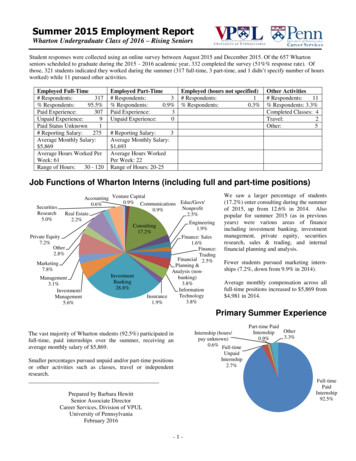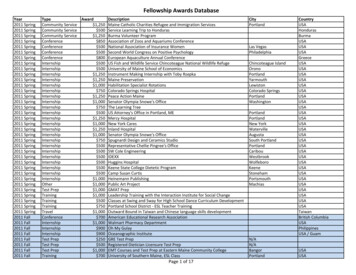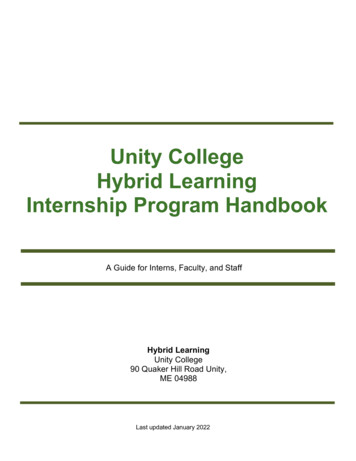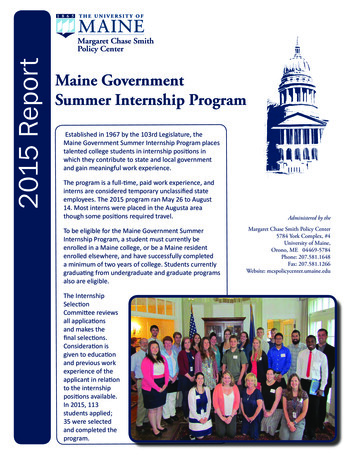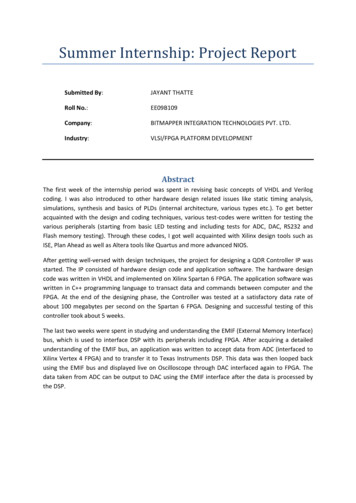
Transcription
Summer 2016 Internship Abstract BookPhoto by Yue Sun, 2016
Name:Title:Preceptors:Agency:Riyaz AbidiGLP-1 Co-Agonist and Obesity - A Retrospective StudyDr. Syed W. Rizvi (M.D-Endocrinologist)Agha M. Abbas (Senior Clinic Manager)R-Endocrinology (Hamilton NJ), Imamia Medics InternationalName:Title:Preceptors:Agency:Ayesha BanerjeeQuality Direct Service Employees & Employers Survey AssessmentSarah Murchison, Human Services CoordinatorSomerset County Department of Human Services: Office of Operations and Planningand Human Services Advisory CouncilName:Title:Preceptors:Agency:Jamie BergerExploring the Prevalence of Intestinal Parasites in Companion AnimalsDirector and Project Supervisor: Scott Turowsky, DVM, Associate VeterinarianMillburn Veterinary Hospital and Laser Surgery CenterName:Title:Preceptors:Agency:Christina CadetSun Safety AwarenessDirect and Project Supervisor: Noah Hetzell, Assistant Health OfficerCumberland County Health DepartmentName:Title:Preceptor:Agency:Emily ClarkColorectal Cancer Detection Test Superiority DeterminationEvelyn Robles-Rodriguez, DirectorCooper University Hospital, Camden, NJName:Title:Preceptors:Agency:Eric DererGrowth Management Plan AnalystMirah Becker, PP, Director of Comprehensive PlanningMiddlesex County Office of PlanningName:Title:Preceptors:Agency:Jasmeen DhillonUnderstanding the Unmet Needs of FamiliesJessica Delgado, CoordinatorPrevent Child Abuse - New JerseyName:Title:Preceptors:Agency:Adam DiSarroHillsborough Township Community ProfileSupervisor: David K. Maski, Planning DirectorHillsborough Township Planning and ZoningName:Title:Preceptors:Agency:Evan DunatovEpidemics and WebMD Web trafficEric Bursack , Director of Client ServicesWebMD, New York, NYName:Title:Preceptors:Shelly EspejoCorrelations Between Failed Large to Mid-sized Nonprofits: A Closer Look at Why Nonprofits FailDirect Supervisor: Sandra Cristina Guerra, LMSW, Program AdministratorProject Supervisor: Sandra Cristina Guerra, LMSW, Program AdministratorThe Fordham Center for NonProfit Leaders (FCNPL)Agency:12345678910
Name:Title:Preceptors:Agency:Chrystal EstevezThe Role of Emotional Intelligence in Work-Life BalanceVincent D. Joseph, Executive CoachRobert Wood Johnson University Hospital, New BrunswickName:Title:Preceptors:Angelica Kene EzeigweInhibiting Trichomonas Vaginalis Virus Uptake in Human CellsRaina Fichorova, MD, PhD, Lab Director, Hidemi Yamamoto, BA, Lab Managerand Gabriela Santone, BS, Lab MemberBrigham and Women’s Hospital, BWH STARS tle:Outcomes from Safety Ambassador ProgramDiana Starace, Injury Prevention Program Coordinator; Carol Lavitt, Safety AmbassadorProgram CoordinatorRobert Wood Johnson University Hospital, Trauma and Injury ica FelicianoJewish Renaissance Medical Center Needs Assessment and Market AnalysisProject Supervisor: Jorge Cruz, Chief Strategy OfficerJewish Renaissance Medical Center (JRMC)Name:Title:Preceptors:Agency:Alexandra GrambonePatients’ Knowledge of Continuing Exercise After Shoulder InjuryKevin Corso, Clinical Director/ Physical TherapistProfessional Physical TherapyName:Title:Preceptors:Emma HaggertyForming a Winning Solution To The Gig Economy in VermontDirect Supervisor: Tara Pereira, Intern ManagerCompany Supervisor: Pat Heffernan, President of Marketing Partners and member ofVermont Businesses for Social Responsibility and Women Business Owners NetworkMarketing Partners, Inc., Burlington, VTAgency:Name:Title:Preceptors:12Mohammed FarooquiCarly FeinPhase II Study of the Effectiveness of Trastuzumab in Combination with Capecitabine/Cisplatin in Patients with Metastatic HER2-positive Gastroesophageal Junction and Gastric CancerPrincipal Investigator: Yelena Y. Janjigian, MD Direct Supervisor: Nickolas Sophos,M.S., Clinical Research SupervisorMemorial Sloan Kettering Cancer, New York CityPreceptors:11Agency:I’antha Trishia HarveyCertified Nurse Assistant Orientation Manual for New HireDirect Supervisor: Jennifer Moyer RN, Director of NursingProject Supervisor: Scott Carpenter, Nursing Home AdministratorLaurel Square Healthcare & Rehabilitation Center (Formerly Marwood Rest Home)Name:Title:Preceptors:Agency:Grant HirschbergAssessing the Level of Patient Education at an Optometrist OfficeDirect Supervisor: Dr. Nancy Argano, O.D.; Project Supervisor: Kim, Office ManagerEye Physicians of Central Jersey13141516171819
Name:Title:Preceptors:Agency:Alana JimenezWater lead sampling in NJ schools- Oak Ridge State UniversityGary Schwartz, CIH, CSP, CMC, Company OwnerPHASE Associates LLCName:Title:Preceptors:Agency:Maanaza KalseeUnion Township Community CPR ProgramJoseph McTernan Senior Director of Community & Clinical ServicesTrinitas Regional Medical CenterName:Title:Preceptors:Agency:Joyanna KarugaChronic Disease Self-Management Program and Diabetes Self-Management Program AssessmentJohn Dowd; Division Head Public Health Preparedness and Health EducationProject Supervisor: Teri Manes; Health Educator, Twyla Paige; Health EducatorMiddlesex County Offices of Health ServicesName:Title:Preceptors:Agency:Zachary KazarianMeal Planning: A Healthy Tool for FamiliesSara Elnakib, Family & Community Health Sciences EducatorRutgers Cooperative Extension of Passaic CountyName:Title:Preceptors:Agency:Amreen KhanThe Home Fire Preparedness CampaignDavid Huang, Disaster Program Specialist for the American Red CrossAmerican Red Cross New Jersey RegionalName:Title:Preceptor:Agency:Naiha KhanAn Examination of Preparation and Operations for Zika Virus in New JerseyWendy Sheay, Public Health Planner, Emergency Preparedness and OperationsNew Jersey Department of Health (NJDOH), Division of Public Health Infrastructure,Laboratories and Emergency Preparedness (PHILEP)Name:Title:Preceptors:Agency:Saadiah KhanCommunication amongst HospitalsDirect Supervisor: Prof. Mrs. Afua A.J. Hesse; Project Supervisor: Ethel B.Accra Medical CollegeName:Title:Preceptors:Agency:Cindy KrampahSIHLE in New BrunswickDirect Supervisor: Deloris Dockrey; Project Supervisor: Tyeisha AdamsHyacinth AIDS FoundationName:Title:Preceptors:Agency:Cynthia LewitterPreventing line of duty deaths for first respondersDirect supervisor: Ginny Rizzo, Secretary and Mike Gallagher, Fire MarshalMiddlesex County Fire AcademyName:Title:Preceptors:Agency:Alec MaisManagement of Diabetic Adolescents in a Summer Camp EnvironmentDirect/Project Supervisor Joanne Oventhal RN BSN MSN, Medical DirectorBlue Rill Day Camp20212223242526272829
Name:Title:Preceptors:Agency:Ta’tyana ManningAmending Health Ordinances for Exterior Property MaintenanceProject Supervisor: Jacqueline Foushee, P.E., C.M.E - Director, Department of Community DevelopmentCity of Rahway, Department of HealthName:Title:Preceptors:Agency:Sanya NagpalA Digital Revolution in Healthcare and PharmaceuticalsMariam Ahmed, Co-Founder & VP of Business DevelopmentNavinata Health, Inc.Name:Title:Preceptors:Agency:Sampada NandyalaHealthcare Experience Assessment Among Older People with HIVDeloris Dockrey, MPH, Director of Community OrganizingHyacinth AIDS FoundationName:Title:Preceptors:Agency:Swathi NarayanThe Essential Use of Integrative Medicine for Stress ReliefDr. Babita SaaraswatGeom Physicians LLC, Integrative MedicineName:Title:Preceptors:Agency:Jackson NgatiaTrend Analysis of Tuberculosis (TB) Middlesex County CasesJohn Dowd, Marybeth Caruso and Teri ManesMiddlesex County Office of Health Services, Tuberculosis ClinicName:Title:Preceptors:Agency:Martina OkoloRedevelopment Planning: Promoting Movement & Economic OpportunityMichele Alonso, Director of Planning and RedevelopmentAsbury Park City Planning and RedevelopmentName:Title:Preceptors:Agency:Zain PadelaD.E.S.I SEHAT - Colorectal Cancer Screening Education and Outreach ProgramUsman Khan, Health Educator; Sharon Manne PhD, Population StudiesRutgers Cancer Institute of New JerseyName:Title:Preceptors:Agency:Anish PatelBringing Restorative Justice into the New Brunswick-Rutgers University PartnershipT.K. Shamy, City Attorney, City of New BrunswickCity of New Brunswick Law DepartmentName:Title:Preceptors:Agency:Anjeli PatelCity of Newark Community Asthma AssessmentDr. Felesia Bowen, PhD, DNP, APNCenter for Urban Youth and Families at Rutgers University School of NursingName:Title:Preceptors:Bhavin PatelEvaluation of Emergency Shelter and Wraparound Services for Homeless FamiliesPaula Massa,Affiliates Projects AssociateRyan Berens,Technical Services AssociateFamily Promise, Inc.Agency:30313233343536373839
Name:Title:Preceptors:Agency:Dhara PatelCompany-wide Newsletter ProjectDirect and Project Supervisor: Veronica Guevara, EMR CoordinatorRiverside Medical Group, Secaucus, NJName:Title:Preceptors:Agency:Rinal PatelAmerican Red Cross Disaster Support ServicesDirect Supervisor: Michael Prasad, Director of Disaster Support ServicesAmerican Red Cross, New Jersey RegionName:Title:Preceptors:Agency:Matthew RollinsFleet Management CommitteeDirect Supervisor: Richard Washart, Assistant Director of EMS OperationsAtlanticare Regional Medical CenterName:Title:Preceptors:Agency:Claudia RugamaEvaluation of Healthy Corner Store Model in TrentonDirect Supervisor: Maria Victoria Coll, DDS. MPH, Regional Director of NJ and NYAmerican Heart Association, New Jersey/New York Regional OfficesName:Title:Preceptors:Agency:Gina RuscilLeadership Resource LibraryWarren Moore, President and CEO & Ruth Bash, VP and Chief Culture OfficerChildren’s Specialized HospitalName:Title:Preceptors:Agency:Dhruv SandilyaSummer Support Presentation on Success Factors: Session Assistant InternDirect Supervisor: Gillian Flowers, Clinical Practice SupervisorProject Supervisor: Erin Murray, Practice LeaderMemorial Sloan Kettering Cancer CenterName:Title:Preceptors:Agency:Cayla SekulerAnalysis on the Impact of Bill S685 on Facilities in Monmouth CountyLizbeth Davies, Field OrganizerPallone for CongressName:Title:Preceptors:Agency:Kareem ShamaStrategic Planning in an Academic InstitutionLinda Tanzer, Chief Administrative OfficerCancer Institute of New JerseyName:Title:Preceptors:Agency:Evelyn SotoFinancial Benefits of Leading with SafetyChristine Stanis, Safety Specialist & Beth Hurley, VP of Safety and HealthCovantaName:Title:Preceptors:Agency:Yue SunDevelop Middlesex County Water Resources Association Annual Report PosterMirah Becker, PP, Director of Comprehensive PlanningMiddlesex County Office of Planning40414243444546474849
Name:Title:Preceptors:Agency:Humna SyedAssessing Physician Office Assistant’s WorkloadBennett Charles SteinMemorial Sloan Kettering Cancer CenterName:Title:Preceptors:Agency:Andres UmañaIdentifying the Utilization Trends for Medical Services Based on Disease Status for Zip Code 07206: TheElizabethportJoseph McTernan, DHSc, MBA, FACHE Senior Director Community and Clinical ServicesTrinitas Regional Medical Center, Elizabeth, NJName:Title:Preceptors:Agency:Jessica UscamaytaSystematizing an Office for the Inclusion of Employees with AutismMolly Ola Pinney, Founder/ CEOGlobal Autism Project, Brooklyn, NYName:Title:Preceptors:Agency:Ishita VohraExposure to New Foods AssessmentCricket Azima, Founder and Big Cheese of The Creative KitchenKatie Auerbach, General Kitchen Aide Event EmulsifierThe Creative KitchenName:Title:Preceptors:Agency:Adrienne WilliamsHuman Papillomavirus Infection Rates and Vaccination EducationDr. Jeffrey HofmanUniversity Medical Center of Princeton at PlainsboroName:Title:Preceptors:Agency:YeanYean WongYouth Leadership DevelopmentProject Supervisor: Karen Winlund, Youth ServicesAmerican Red Cross, New Jersey RegionName:Title:Preceptors:Agency:Nora YosryEducating Mothers on Prevention of Premature BirthDr. Hany El-Slamony, Assistant Director of Maternal and Child HealthThe World Health OrganizationName:Title:Preceptors:Agency:Nicole YoumansSummer Camps Kids Healthy Habits EvaluationEmma Lopez, Health EducatorVineland City Health DepartmentName:Title:Preceptors:Agency:Naba ZamirDigital Health Formula - Combining Technology & Public HealthMaureen Koval, Lead Analyst and Project SupervisorJohnson & Johnson Consumer Inc.505152535455565758
Internship AbstractTitle:GLP-1 Co-Agonist and Obesity - A Retrospective StudyName:Riyaz AbidiPreceptors:Dr. Syed W. Rizvi (M.D-Endocrinologist)Agha M. Abbas (Senior Clinic Manager)Agency:R-Endocrinology (Hamilton NJ), Imamia Medics InternationalPurpose: To conduct a retrospective study on the efficacy of GLP-1 receptor co-agonist drugs on obesitycontrol and lowering weight/BMI, based on patient data collected.Significance: According to CDC there are approximately 78.6 million obese Americans including a70.7% of adults consisting of the age of 20 and older, and 46.6% of children and adolescents from ages 2through 19. Obesity is defined as being grossly fat or overweight between the 85th to 95th Body MassIndex percentile of height to weight ratio, in both adults and children. A drug known as Glucagon LikePeptide-1 Receptor Co-Agonist (GLP-1) was introduced to control glucose levels in body and boostmetabolism. Research shows GLP-1 co-agonist drugs help reduce weight/BMI. Physicians now areprescribing GLP-1 co-agonist drugs to patients, to control their weight and BMI. This cohort study,evidently explains the correlation between GLP-1 drugs and obesity.Method/Approach: A retrospective, longitudinal cohort review was completed to assess the efficacy ofGLP-1 co-agonist drugs on weight reduction. Patient data for 67 obese men and women (currently onGLP-1 drugs) from ages 27-80, in the past 10 years was exported to an excel spreadsheet, and of those, 24did not have data recorded. After proper investigative protocol, probed clinical soap notes, nutritionalsheets, BMI and patient interview, the data was further exported to SPSS for correlations and descriptivestatistical review. Of these patients, 37 (72.5%) showed an decrease in weight and BMI, 4 (7.8%) showedno increase or decrease in weight or BMI, and 10 (19%) showed an increase in weight and BMI.Results: Of the 51 of 67 that had data, 37 (72.5%) patients showed an decrease in weight/BMI in which25 were female. 4 (7.8%) patients showed no increase or decrease in weight/BMI of which 3 were female.And 10 (19%) showed an increase in weight/BMI of which 7 were female. The mean BMI before/afteruse was 39.152 and 38.037 respectively with a Standard deviation of 11.82/11.18 respectively. ThePearson’s R value is .915 and spearman correlation of 9.08 significant at the 0.01 level. Paired sampleT Test results at the 95% confidence interval had .003 significance.Conclusion: More than half (n 37) of the sample size cohort had an decrease of weight/BMI after takingGLP-1 co-agonist. The results prove a strong positive correlation between GLP-1 Drugs and reduction ofobesity, as well as prove to be an effective method of weight loss/lower BMI. Physician recommendation,pamphlets, and televised marketing use of GLP-1 Drugs will (a) help reduce obesity, (b) lower obesityprevalence and (c) raise awareness against population obesity. Those patients had negative or no effects,may not have taken the dosage properly, not exercised daily and or not a balanced diet.1
Internship AbstractTitle:Quality Direct Service Employees & Employers Survey AssessmentName:Ayesha BanerjeePreceptors:Sarah Murchison, Human Services CoordinatorAgency:Somerset County Department of Human Services: Office of Operations and Planningand Human Services Advisory CouncilPurpose: To survey non-profit organizations in Somerset County by assessing employers and employeesin direct service to improve the quality of care and their compensation.Significance: Over the past 8 years, the State of New Jersey’s funding towards direct care workers hasnot increased. Somerset County Non Profit Purchase of Service Funding to human services contracts fordirect services only increased at most 2% per year over the past 3 years. From 2009 to 2013, fundingremained stagnant. Direct Service employees play a vital role to servicing individuals. Therefore, theyneed to be paid at the rate that increases the ability to recruit quality employees and improves theconsistency and the quality of services provided. According to a Division of Developmental DisabilitiesSurvey done by NJ Department of Human Services in July 2011, the number of individuals who are inneed of care surpass the few number of direct service workers. The Direct Service Survey assesses theimpact of the lack of increase in salaries for the quality of services provided in Somerset County anddeterminates a method to retain qualified direct service employees.Method/Approach: This task for assessing Quality Direct Service employees came out of the 2016-2020Human Services Priority Populations planning process. The Human Services Advisory Council (HSAC)oversees the assessment of human services priority populations needs in Somerset County, providing thiscounty with plans and administers State grants. After analyzing unmet needs for the priority populations,one of the unmet needs identified was quality workers. As part of the plan’s implementation, QualityStaff was assigned to a planning subcommittee. The committee intends to survey the direct serviceemployers and employees of all non-profit organizations in Somerset County. The questions asked assistin the justification of the unmet need and the manner by which quality of service and appropriatecompensation is then to be resolved. Survey availability is online through Survey Monkey and papercopies, which are manually entered online.Results: Once the committee receives feedback from the Direct Service Surveys, HSAC plans tosubstantiate the need and retain the workers across all human services in the county. These initiatives areto ultimately increase the quality of service provided and reducing the turnover rate. As turnover ratedecreases, organizations improve their work quality, productivity and lower the cost of turnover, whichinclude costs like hiring, training, and productivity loss.Conclusion: After the construction of preliminary surveys, there is distribution of the survey to themembers of HSAC and their nonprofit organization employees. Once their organizations and memberscomplete the survey, they are to provide feedback on the efficiency and the effectiveness of the survey.Once there is preliminary analysis of the results, the committee plans to send out this survey to the rest ofthe nonprofits in Somerset County.2
Internship AbstractTitle:Exploring the Prevalence of Intestinal Parasites in Companion AnimalsName:Jamie BergerPreceptors:Director and Project Supervisor: Scott Turowsky, DVM, Associate VeterinarianAgency:Millburn Veterinary Hospital and Laser Surgery CenterPurpose: To investigate the prevalence of intestinal parasites in a canine and feline companion animalpopulation in order to better understand the potential zoonotic risks.Significance: Zoonotic diseases are “disease[s] that can be passed between animals and humans.”Specifically, gastrointestinal parasites spread from companion animals to humans through fecal, oral, orskin contact. According to the Companion Animal Parasite Council, owners often lack awareness andknowledge of zoonotic risks. One study found that over 34 percent of dogs will become infected withgastrointestinal parasites while 1 to 3 million people are zoonotically infected with roundworm.Method/Approach: A retrospective review was completed to assess the prevalence rate of intestinalparasites among patients at Millburn Veterinary Hospital and Laser Surgery Center from March 5, 2016to July 9, 2016. Data for 319 dogs was exported to a spreadsheet. Sixty-three dogs tested positive. Datafor 45 cats was exported to a spreadsheet and 9 tested positive. Investigative protocol probed data, testsand results from IDEXX Laboratories. Fecal results included: 1. Giardia Elisa, 2. Giardia cysts, 3.Roundworm (Toxocara), 4. Hookworm, 5. Tapeworm, 6. Whipworm, 7. Coccidia, 8. Flea tapeworm and8. Capillaria Sp. Ova.Results: Of the 319 dogs, 63 had intestinal parasites (19.75%); 27 (8.46%) 0-1 year olds tested positivefor Giardia Elisa; 4 (1.25%) 6 tested positive for Giardia Elisa; 6 (1.88%) 0-1 year olds tested positivefor Roundworm (Toxocara); 4 (1.25%) 2-5 year olds tested positive for Coccidia; 5 (1.56%) 0-1year oldstested positive for Giardia cysts; 5 (1.56%) tested positive for hookworm; 1(.31%) 0-1 year olds testedpositive for Capillaria Sp. Ova. Of the 45 cats, 9 had intestinal parasites (20%); 3(6.66%) 6 testedpositive for Giardia Elisa; 1 (2.22%) 6 tested positive for flea tapeworm, Giardia cysts and hookworm; 1(2.22%) 2-5 year olds tested positive for Giardia Elisa and roundworm (Toxocara); 1 (2.22%) of cats 0-1year of age tested positive for Coccidia.Evaluation: Approximately 19.75% (63) of the dogs tested positive while 20% (9) of the cats testedpositive for intestinal parasites. Communicating effectively with owners during exams, (especially withnew puppies and kittens), handing out informational packets and performing annual testing will serve aseffective strategies to (a) increase the detection of parasitic infections, (b) decrease the prevalence ofdisease and (c) raise awareness for zoonotic diseases.3
Internship AbstractTitle:Sun Safety AwarenessName:Christina CadetPreceptors:Direct and Project Supervisor: Noah Hetzell, Assistant Health OfficerAgency:Cumberland County Health DepartmentPurpose: To create outreach material in order to promote sun safety awareness for the residents ofCumberland County.Significance: In the United States, one out of five Americans will develop some type of skin cancer intheir lifetime (Skin Cancer Foundation, 2016). According to the CDC, most skin cancers are partly due toexcessive UV ray exposure. One out of every three adults in the U.S. have been sunburned in the pastyear, and they are not taking the necessary precautions to protect themselves (2016). This educationalvideo is necessary to teach the residents of Cumberland County the importance of sun safety, in order todecrease sunburn frequency.Method/Approach: Research was conducted to find sun safety tips and cancer statistics from reputablesources, such as the CDC and the American Cancer Society. This information, as well as captivatingphotos, were put together in a four minute video with a voice over using Windows Movie Maker. Thepurpose of the pictures was to help viewers make a connection with each topic. The script for the videowas made so the average county resident could comprehend the material with little difficulty. In order totest the video after it is made, a group that represents the population of the county was needed to critiquethe material. After the video was created, it was tested among the residents of Cumberland County beforeit was released to the public. The residents were asked if the video was easy to understand, if it providedthem with new information, if there were any concepts that needed to repeated, and if there was any otherinformation that should be included in the video. After this information was collected, the video wasedited and released to the Cumberland County Department YouTube and Facebook page.Results: In the time span of two weeks, the video received 12 views from YouTube and four likes fromthe Facebook page.Conclusion: The video was shown to a group of 21 Cumberland County residents at the county fair. Thegroup consisted of seven adults and 14 school children, varying from grade school to high school. Theresidents thought that the video was not hard to understand for the most part, but some concepts needed tobe repeated to make it stick. One resident thought that information on expired sunscreen should be addedinto the video. The residents thought that the information presented in the video was useful, one inparticular expressed that he has dealt with many sunburns in his lifetime and wished he knew thisinformation before. Many expressed that they were not aware about some of the information presentedabout sun safety. After these observations were made, the video was edited with the requestedinformation.4
Title:Internship AbstractColorectal Cancer Detection Test Superiority DeterminationName:Emily ClarkPreceptor:Evelyn Robles-Rodriguez, DirectorAgency:Cooper University Hospital, Camden, NJPurpose: To compare the Hemocult ICT versus the OC-Auto Fecal immunochemical tests (FIT) as partof the colorectal screening process through evaluation of collected data and further research.Significance: Colorectal cancer is the second leading cause of cancer-related deaths in the United States.In the past few decades, the death rate due to colorectal cancer has been decreasing for both men andwomen. This can be attributed to proficient screening techniques, which find polyps before they becomecancerous, or are in the earlier stages of the disease; thus an important to have the most effectivescreening technology. The FIT assays are part of the one or two-step process presently used to screen forcolorectal cancer. This study will provide data to support the claim that OC-Auto FIT assay, currentlyused by the Camden County Cancer Screening Project (CCCSP) at Cooper University Hospital, is moreeffective than the Hemocult ICT FIT test, which was formerly used by the screening project, in screeningfor colorectal cancer. This evidence-based evaluation of the two tests could be used to prove the need forthe FIT kits as an essential part of the cancer screening process at CCCSP and cancer screening programsalike.Method: Data collected from colorectal cancer screenings at Cooper University Hospital from July 2013to June 2016 from the Camden, NJ area. During this time, both the Hemocult ICT and OC-Auto FITassays were used, with the implementation of the latter on November 21, 2014. The CCCSP at CooperUniversity Hospital administers free colorectal screening by providing patients with a colorectal screeningkit during an office visit and relying on the patient to complete the kit at home. The fulfillment of the kitis contingent upon a bowel movement and the timely return of a swab of the specimen via the mail in apre-stamped envelope, which is sent directly to a lab for analysis. To note, the Hemocult ICT assayrequires that the patient take stool samples from bowel movements from two days while following arestricted diet and medication intake. The OC-Auto FIT works similarly, however, the samples are onlycollected over a one-day period and the test does not impose restrictions on food or drugs. A positive testresult indicates the presence of blood in the stool, which could indicate cancer, or pre-cancer in the colonor rectum. The patient is then referred for a colonoscopy, which is often covered by charity care. Thevalues from both FIT assays were contrasted, and the data was discussed with members of The CancerScreening Project to determine the implications of the values.Results: After switching to the OC-Auto FIT assay, there was an overall 9% increase in the number ofreturned colorectal screening tests. A 35% decrease in the number of positive test results was observed inthe OC-Auto FIT assays as compared to that of the Hemocult ICT tests. There was also an 11% increasein the negative test results after the switch.Conclusion: Overall, the OC-Auto FIT assay was overall found to be more effective in testing forcolorectal cancer than the Hemocult ICT FIT for the CCCSP. However, this study cannot measure truesensitivity as not all patients received colonoscopies following the screening to confirm the results of thescreening tests. Most importantly for the cancer-screening project, the OC-Auto FIT assays are correlatedwith the number kits that are completed and returned to the lab for evaluation. This is primarily due to theconvenience of the OC-Auto FIT assay versus the original Hemocult ICT for the patient. This increase isan important factor in reducing the incidence of colorectal cancers.5
Internship AbstractTitle:Growth Management Plan AnalystName:Eric DererPreceptors:Mirah Becker, PP, Director of Comprehensive PlanningAgency:Middlesex County Office of PlanningPurpose: To research and analyze advancing technologies in urban and suburban settings to incorporateand make recommendations for Middlesex County’s new growth management plan.Significance: Technology can provide linkages and better connections between government departmentsand the work that they are responsible for carrying out. The field of ‘smart cities, a subfield within thedomain of smart growth, focuses on enhancing quality of life through improved technology andcommunication. One example of smart city technology is Motor City Mapping. The organization “Is acomprehensive effort to digitize Detroit’s property information and create clear communication channelsback and forth between the public, the government, and city service providers” (motorcitymapping.org).The consolidation of Detroit’s property data has expedited the process of removing blight from the city.Technology and data can also improve the involvement of residents, as Code for Philly has done. Thisorganization aims to use tech and data for civic engagement through the creation of applications createdby residents that are meant to improve citizens daily life (codeforphilly.org/pages/mission). It can be seenthat it is important to include ideas and recommendation for technological advancement that will benefitthe public in new growth management plans. Middlesex County is one of the fastest growing counties inNew Jersey, and urban and suburban IT will help improve the lives of its residents through more openinformation, accessibility and convenience.Method/Approach: Since the field of urban technology is very broad, defining the concept inrelationship to the county is imperative. after some research the keyword ‘smart cities’ was found to bepertinent to Middlesex County’s growth management plan. Currently, there is no u
Agency: Trinitas Regional Medical Center 21 Name: Joyanna Karuga Title: Chronic Disease Self-Management Program and Diabetes Self-Management Program Assessment . Agency: Center for Urban Youth and Families at Rutgers University School of Nursing 38 Name: Bhavin Patel Title: Evaluation of Emergency Shelter and Wraparound Services for Homeless .
